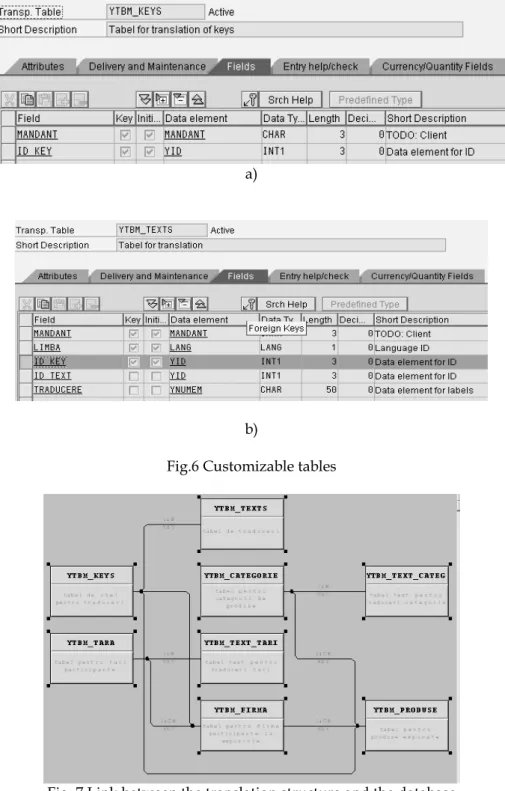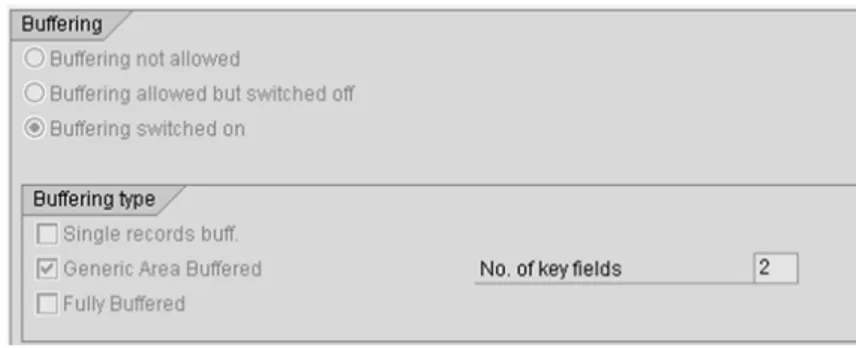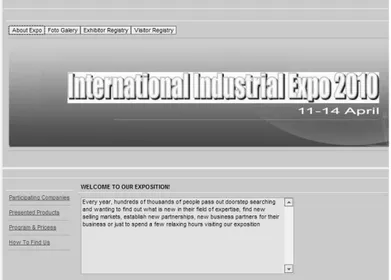Modalities to Implement the Multilinguality
in Web DYNPRO ABAP
Mihaela OSACI
mihaela.osaci@fih.upt.roPolitehnica University of Timisoara, Engineering Faculty of Hunedoara
Adela Diana BERDIE
adela.berdie@fih.upt.ro
Politehnica University of Timisoara, Engineering Faculty of Hunedoara
Ana Daniela CRISTEA
anadaniela05@yahoo.com
NWCON Technology Consulting GmbH, Germany
Emil Dragomir MOLNAR
med11rom@yahoo.com UniCredit Tiriac Bank , Deva
Abstract
The integrated platform SAP Netweaver is a platform that offers support in realizing Web bussiness applications that use the Model View Controller (MVC) concept. The
Multilinguality being a property of this platform. The purpose of this article is to highlight the modality to internationalize a Web Dynpro ABAP project The techniques used for the internationalization of a Web Dynpro ABAP application are: the OTR [Online Text Repository] translations, the implementation of the assistance class and the technique of information internationalization in a database. The case study has been performed on the trial “SAP Netweaver 7.0 Application Server ABAP” that offered the possibility to log-in in English and German languages.
Keywords: Computer programes, software
JEL Code: C 880
1. The Web Dynpro ABAP concept
The “Web Dynpro ABAP” is the SAP Netweaver concept for developing interfaces with the user. It represents the current standard for performing the Web bussiness applications in the ABAP environment. The Web Dynpro ABAP framework includes an execution environment and a graphical development environment, by using special Web Dynpro tools integrated in the ABAP Workbench (SE80 transaction). It provides a uniform interface for different application scenarios.
This framework is realized according to the Model View Controller (MVC) paradigm. MVC is an architectural model that divides the application implementation in three components: model, view and controller. The model component includes the logical part of the application, the view component ensures the display on screen, and the controller component realizes the link between the model and the view, defining how the user interface reacts to the user’s actions. The benefit of this MVC architecture is the separation of the project logic from the presentation logic.
In case of a Web Dynpro framework (Fig.1 [1]), the design data separation is realized through objects that generate data and objects that consume data, the entire structure being made of components [2].
eCATT (extended Computer Aided Test Tool) scenarios, and for client’s integration - SP Smart Board type [3].
Fig.1 Web Dynpro ABAP Architecture
One of the advantages offered by the Web Dynpo in developing the web applications is the internationalization. Its purpose is to ensure the technical base required to allow the web applications to run in the log-in language. When a user logs-in in a certain language, the system must run the application in the respective language.
2. Internationalization techniques for a Web Dynpro ABAP application
Any Web Dynpro ABAP component is created in the log-in language (e.g. in English). When testing the application based on this component, the display language is English. For making this application to run in a different language, the interface information shall be displayed in this language. All the components of a WebDynpro application can be independently internationalized and displayed. There are some standard techniques used to internationalize the Web Dynpro applications.
a. The internationalization technique OTR (Online Text Repository) is used to translate static
texts. Online Text Repository (OTR) is the central location for storing texts. The main task of the
OTR is to support the creation and translation of texts. There are two methods for creating texts in OTR: by using the transaction SOTR_EDIT or directly from the view of the component Web
Dynpro, by using the Goto menuand the Online text Repository Browser command. By using the
transaction SOTR_EDIT, we create an alias for the text in the log-in language. This text is linked with an UI element from the view of the component Web Dynpro and, with the SE63 transaction (Fig. 2), we realize the translation from the log-in language in the desired language. The trial version “SAP NetWeaver Application Server ABAP 7.0” includes only two log-in languages: English and German.
b. The message internationalization technique
The messages are dynamic texts. In the system, there is an abstract SAP class
cl_wd_component_assistance [3] that can help us to internationalize. So, for each wd component we can assign the created assistance class, which inherit the SAP class cl_wd_component_assistance (Fig.3).
Fig.3 The global class cl_wd_component_assistance
Fig.4 Text symbols defining
At the properties of the Web Dynpro component, we mention the name of the assistance class and define the respective dynamic text symbols (Fig. 4), which are translated by using the menu “Go to translation” (Fig. 5). In the respective code of the messages, we use, instead of the text to be displayed, the afferent text symbol that populates the key parameter of the get_text method of the if_wd_component_assistance interface [4], [5].
e.g. text1 = wd_assist->if_wd_component_assistance~get_text( key = ‘001’ ).
c. Internationalization of the database
The translations are customizable operations performed only by the application administrator. To internationalize the information included in the field of a transparent table, information accessed through “search helps” (global object realized in Data Dictionary, for browsing), we used an associated text table, and for the internationalization of the information included in the update database tables, we realized a customizable table structure (Fig. 6 a, b) made of two tables: a key table and a text table, linked 1 to n with the key field property of a text table, which is linked with the database in a way that avoids the damage of its consistency (undefined link) (Fig. 7) [6], [7].
a)
b)
Fig.6 Customizable tables
Because the records included in the key table are rarely changing, it is advisable to use the buffering property (Fig. 8). At the first reading of a record included in this table, the records that correspond to the buffering type option are placed in a special memory zone, so that, at the second reading, the records are taken from this memory zone. Buffering is preferred for improving the performance, in case of frequent readings from the database [8].
Fig.8 Technical settings of the buffering options
For the translation table structure [3], it is realized a maintenance view by using the se11
translation, through which the data included in these tables are updated. In themaintenance view
[1], the data form a logic unit for the user. So, the data of this unit can be displayed, modified or added. The user can manipulate the data without being interested in the technical part of the database implementation (he doesn’t care if the data come from the fields of different tables) (Figs. 9, 10).
Fig. 9 Translation through maintenance view
Fig. 10 Text table updating through maintenance view
3. The result of implementing the internationalization techniques in the case study
Fig. 11 Log-in in English
Fig. 12 Log-in in German
The messages are internationalized by using an assistance class available for the entire project. In this class, all the messages of the application are defined by keys (Figs. 13 and 14).
Fig.14 Message in English
Hereunder, there are presented the tables that include the information regarding the products registered by the participant companies, internationalized in the two log-in languages (Figs.15 and 16).
Fig.15 Presentation of the information included in the products table, in English
Fig.16 Presentation of the information included in the products table, in German
Conclusions
Based on the ABAP platform, the Web Dynpro anticipates a complex development in building IT projects, performed by groups of designers, due to the componentizing and usage techniques [3]. The current SAP technologies offer the possibility to re-use the components and not only the code (other programs or programming environments can re-use only the code).
An internationalized application offers not only technical and organizational information, but especially the possibility to access this information in different world languages, this one being a major advantage for any multinational or event planning company.
References
[1] SAP Help Portal (http://help.sap.com); [2] SAP Developer Network (http://sdn.sap.com);
[3] Ulli Hoffmann, Web Dynpro for ABAP, Publishing House: SAP Galileo Press, Bonn, Germany, 2007; [4]
http://www.sdn.sap.com/irj/scn/index?rid=/library/uuid/506afd46-32df-2b10-99b0-b93b19075cb1&overridelayout=true;
[6] Web Dynpro ABAP Programming Guidelines (SAP AG 2006), available in electronic format (pdf) on the Internet network;
[7] Rich Heilman, Thomas Jung, Next Generation ABAP Development, Publishing House: SAP Galileo Press, Bonn, Germany, 2007


